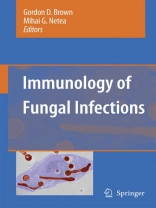Table of Content
Preface
Section 1: Cells
chapter 1: Macrophages
Sigrid E.M. Heinsbroek and Siamon Gordon; University of Oxford
chapter 2: Dendritic cells
Luigina Romani; University of Perugia
chapter 3: The neutrophil
David H. Dockrell, Emmet E. Mc Grath, Moira KB Whyte, and Ian Sabroe; University of Sheffield
chapter 4: Lymphocytes
Anna Vecchiarelli, Antonella Mencacci, Francesco Bistoni ; University of Perugia
chapter 5: Other cells: The role of non-neutrophilic granulocytes, NK and NKT cells in fungal immunology
Jeremy CD Wiseman and Christopher H. Mody; University of Calgary
chapter 6: Genes and gene pathways in Candida Infection
Robert B. Ashman, Camile S. Fara, and Christine Wells; University of Queensland and Griffith University
Section 2: Soluble factors
chapter 7: Collectins and pentraxins
Uday Kishore and Ken Reid; University of Oxford and Justus-Liebig-University
chapter 8: Complement in fungal infections and complement evasion strategies
Cornelia Speth, Cornelia Lass-Flörl and Reinhard Würzner; Innsbruck Medical University and Ludwig-Boltzmann-Institute of AIDS Research.
chapter 9: Cytokines
Karen F. Buckland and Cory M. Hogaboam; University of Michigan Medical School.
chapter 10: Antibodies
Josè Lòpez-Ribot, Rosalìa Dìez-Orejas and Concha Gil ; The University of Texas at San Antonio and Complutense University
Section 3: Non-Opsonic Fungal Receptors
chapter 11: The recognition of fungal pathogens by Toll-like receptors
Mihai G. Netea, Jos WM Van der Meer, Bart Jan Kullberg; Radboud University Nijmegen Medical Center and Nijmegen University Center for Infectious Diseases
chapter 12: Fungal ß-glucans and their receptors
S Vicky Tsoni and Gordon D Brown; University of Cape Town
chapter 13: Detection of fungi by mannose-basedrecognition receptors
F Meyer-Wentrup, A Cambi, CG Figdor and GJ Adema; Radboud University Nijmegen Medical Center
Section 4: Immunity to specific pathogens
chapter 14: Pneumocystis
Laura Mc Kinley and Chad Steele, University of Pittsburgh School of Medicine
chapter 15: Interactions of Aspergillus fumigatus with its host during invasive pulmonary infections
Jean-Paul Latgé and Anne Beauvais; Pasteur Institute
chapter 16: C. albicans and C. glabrata
Desa Lilic and Ken Haynes, School of Clinial Medicines, Newcastle University and Department of INfectious diseases, Imerpial College London
chapter 17: Immunology of infections with Cryptococcus neoformans
Pauline Ellerbroek, Anna Vecchiarelli, Andy Hoepelman and Frank Coenjaerts; University Medical Center and University of Perugia.
chapter 18: Histoplasma capsulatum
Joshua D Nosanchuk; Albert Einstein College of Medicine
Section 5
chapter 19: Escape mechanisms from the immune response
David M. Underhill; Cedars-Sinai Medical Center
Section 6: Immune-based therapeutic strategies
chapter 20: Cytokine treatment of fungal infections
Bart-Jan Kullberg; Radboud University Nijmegen Medical Center
chapter 21: Fungal vaccines and vaccination: problems and perspectives
Antonio Cassone; Istituto Superiore di Santià
Index












